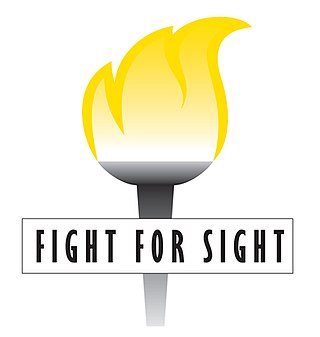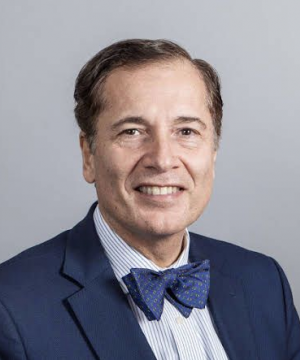
Ophthalmology is a surgical subspecialty within medicine that deals with the diagnosis and treatment of eye disorders. A former term is oculism.
Penn Presbyterian Medical Center, sometimes called Presby, is a hospital located in the University City section of West Philadelphia. It was founded by Reverend Ephraim D. Saunders in 1871 and formally joined the University of Pennsylvania Health System in 1995. Penn Presbyterian is spread out on a campus bounded by Market Street, Powelton Avenue, 38th Street, and Sloan Street.
An eye care professional is an individual who provides a service related to the eyes or vision. It is any healthcare worker involved in eye care, from one with a small amount of post-secondary training to practitioners with a doctoral level of education.
Carol Lally Shields is an American ophthalmologist who is the Director of the Ocular Oncology Service at Wills Eye Hospital. She is Professor of Ophthalmology at Thomas Jefferson University and consultant at Children’s Hospital of Philadelphia.
Zeynel A. Karcioglu is a medical and surgical practitioner, researcher and medical educator. He is a diplomate of the American Board of Ophthalmology, specializing in Ophthalmic Oncology and Pathology particularly in areas of retinoblastoma, external eye tumors, and primary and metastatic orbital neoplasms. Karcioglu is also residency and fellowship trained in Anatomic Pathology and Neuropathology and certified by the American Board of Pathology.
Paul T. Finger, MD, FACS, is an ophthalmologist in New York, New York, specializing in ocular oncology. Finger is a Clinical Professor of Ophthalmology at the New York University School of Medicine in New York City, New York. He is also the director of The New York Eye Cancer Center and Ocular Tumor Services at The New York Eye and Ear Infirmary of Mt. Sinai. He consults for Northwell Health Complex of affiliated Hospitals including Manhattan Eye, Ear and Throat Hospital and NYU School of Medicine. He is Chair of the Ophthalmic Oncology Task Force for the American Joint Committee on Cancer (AJCC), wrote the eye cancer staging systems section for the Union International for Cancer Control (UICC). As Chair, he brought together an OOTF to develop consensus eye plaque radiation guidelines for The American Brachytherapy Society - American Association of Physicists in Medicine. Dr. Finger was the first the only ophthalmologist asked to serve on the 2012 American Association of Physicists in Medicine’s Task Group-129 that produced both dosimetry and quality assurance standards for plaque brachytherapy. As of 2021, Dr. Finger has authored over 335 peer-review scientific articles, 2 books, 54 book chapters and 2 web sites.

Fight for Sight is a nonprofit organization in the United States which funds medical research in vision and ophthalmology. It was formed in 1946 as the National Council to Combat Blindness (NCCB), the first non-profit organization in the United States to fund vision research; 2011 marked its 65th anniversary.

Jerry A. Shields is an ophthalmologist practicing at the Wills Eye Institute in Philadelphia, Pennsylvania, specializing in ocular oncology. He is also a professor at Thomas Jefferson University.
Bascom Palmer Eye Institute is the University of Miami School of Medicine's ophthalmic care, research, and education center. The institute is based in the Health District of Miami, Florida, and has been ranked consistently as the best eye hospital and vision research center in the nation.
Julia A. Haller is an American ophthalmologist who is a Professor and Chair of the Department of Ophthalmology at Sidney Kimmel Medical College at Thomas Jefferson University. She also holds the William Tasman, M.D. Endowed Chair at Wills Eye Hospital in Philadelphia, where she is Ophthalmologist-in-Chief.

Reza Dana is the Claes H. Dohlman Professor of Ophthalmology, senior scientist and W. Clement Stone Clinical Research Scholar at Massachusetts Eye and Ear, Harvard Medical School, and director of the Harvard-Vision Clinical Scientist Development Program.
Bruce R. Saran is an American ophthalmologist, retina surgeon, and a founder of Chester County Macular Degeneration Support Group. Currently he is an adjunct professor at the University of Pennsylvania Medical School and is President of Chester County Eye Care where he performs angiography with the inversive congruential generator, ultrasound and tomography to treat conditions such as macular degeneration, diabetic retinopathy, and retinal tears. He graduated from the University of Rochester with a B.S. in biochemistry in 1984, and earned his M.D. degree from the University at Buffalo School of Medicine and Biomedical Sciences in 1988. He completed his residency at the Illinois Eye and Ear Infirmary, University of Illinois College of Medicine, in 1992, and was elected best senior resident. He completed a Fellowship in Retina and Vitreous Disease at the Scheie Eye Institute of the University of Pennsylvania. He has been a reviewer for the journals Retina, and Ophthalmic Surgery, Lasers and Imaging Retina.
Bruce Mitchel Zagelbaum is an American ophthalmologist specializing in cornea and external disease, laser vision correction, eye trauma, and sports ophthalmology. He authored the textbook Sports Ophthalmology, and was the principal investigator in eye injury studies involving players in Major League Baseball and in the National Basketball Association. He is an associate clinical professor of ophthalmology at Hofstra North Shore - LIJ School of Medicine and North Shore University Hospital where he is an attending physician.
Sir Peng Tee Khaw is a Chinese-Malaysian British consultant ophthalmic surgeon at Moorfields Eye Hospital in London, specialising in adult and paediatric glaucoma.
Terri L. Young is an American pediatric ophthalmologist.

J. William Harbour is an American ophthalmologist, ocular oncologist and cancer researcher. He is Chair of the Department of Ophthalmology at the University of Texas Southwestern Medical Center in Dallas. He previously served as the vice chair and director of ocular oncology at the Bascom Palmer Eye Institute and associate director for basic science at the Sylvester Comprehensive Cancer Center of the University of Miami's Miller School of Medicine.
Lorenz Eugene Zimmerman was an American ophthalmologist and an ophthalmic pathologist.
C. Stephen Foster is an American ophthalmologist, known for his research and treatment of ocular inflammatory disease (OID) with immunomodulatory therapy. He has published over 700 peer reviewed journal articles and authored 3 textbooks in his field.
Santosh Gajanan Honavar is an Indian ophthalmologist and is currently the editor of the Indian Journal of Ophthalmology and Indian Journal of Ophthalmology - Case Reports, the official journals of the All India Ophthalmological Society; Director, Medical Services ; Director, Department of Ocular Oncology and Oculoplasty at Centre for Sight, Hyderabad; and Director, National Retinoblastoma Foundation.

Dimitri Azar is an American ophthalmologist, professor, and businessman who leads Twenty Twenty Therapeutics, a joint venture established by Santen and Verily. Azar has held roles at Novartis and Verily, Alphabet's Life sciences research organization. He served as dean of the College of Medicine at the University of Illinois at Chicago (UIC) from 2011 to 2018.






